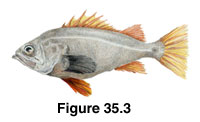 Description
DescriptionSebastes flavidus
(Yellowtail Rockfish)
(Other common names: Yellowtail Rock Cod, Green Snapper)
Figure 35.3
 Description
DescriptionLength: 66 cm.
Mouth: large, terminal; lower jaw projects but does not enter the upper profile; upper jaw extends to just before orbit; snout is pointed; symphyseal knob prominent and projects downwards.
Body: nasal spines weak; preopercular spines stong; two opercular spines strongly developed but thin; cleithral spines weak; supracleithral spine weak or absent; convex interorbital space; anal fin posterior edge is vertical; caudal fin truncate but slightly forked.
Color: olive green with mottled brown; fins and caudal tip is yellow; young often have a black blotch on the caudal fin.
Depth: up to 274 m but most between 24-46 m.
Habitat: pelagic schooling species often found over deep reefs.
Season: ovoviparious; young are born late winter to early spring.
Diet: pelagic crustaceans, fish (e.g., laternfish).
Predators: unknown.
Distribution: southern California to Alaska
 Scale Description
Scale DescriptionRelative Scale Size: moderate.
Position of Scales on Body: below lateral line in 55-60 diagonal rows (Hart, 1973).
Overall Shape: the scales are generally square to rectangular with a short posterior field that is weakly ctenoid.
Focus and Circuli: the focus abuts the edge of the posterior field, along the edge of ctenii growth, approximately one-fourth the total scale length from the outside edge of the posterior margin. The circuli are compact and continuous between the lateral and anterior fields (except broken by radii).
Radii: numbers are variable and not diagnostic. Present presently only in the anterior field. The outer edge of the anterior field edge is straight to slightly convex and is scalloped.